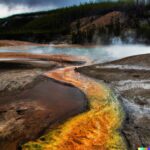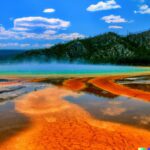Yellowstone National Park is famous for its stunning geysers, natural marvels that captivate visitors with their powerful eruptions. But have you ever wondered how these geysers work?
In this article, we will delve into the fascinating world of geysers, exploring how they are formed, what causes them to erupt, and the different types found in Yellowstone National Park. We will also take a closer look at some of the park’s most famous geysers and their eruption cycles. Join us as we uncover the incredible science behind these mesmerizing natural wonders.
What Are Geysers?
Geysers are natural wonders that result from geothermal activity, characterized by intermittent eruptions of hot water and steam from the ground.
These remarkable natural phenomena are a result of intricate geological processes, primarily driven by the Earth’s internal heat.
The formation of geysers involves a combination of volcanic activity, underground water reservoirs, and specific rock formations. The geothermal conditions underground contribute significantly to the creation of these hot springs, as heated water and steam build up pressure until it eventually erupts through a vent, resulting in the captivating display of boiling water and steam.
Understanding the scientific research behind geysers offers valuable insights into Earth’s dynamic forces and the significance of geothermal conditions in shaping our natural environment.
How Are Geysers Formed?
The formation of geysers involves the interaction of underground water with heat sources, leading to the buildup of pressure and the creation of unique geothermal features.
This intricate process occurs in geyser basins, where underground reservoirs of water are heated by volcanic activity, causing them to expand and rise. As the water ascends, the pressure increases until it erupts through a vent, creating the iconic geyser eruptions.
These geological marvels not only contribute to the stunning landscape but also play a vital ecological role by supporting unique ecosystems around the geyser basins. The exploration of geothermal resources in these areas offers promising opportunities for sustainable energy production and scientific research into Earth’s geological processes.
What Causes Geysers to Erupt?
The eruptions of geysers are driven by a combination of geological forces, including the buildup of pressure, the release of volcanic heat, and the specific behavior of individual geyser formations.
Hydrothermal System
The hydrothermal system underlying geyser activity plays a pivotal role in the release of geothermal energy and the occurrence of various geological events that shape the hydrothermal features of the area.
This complex network of hot water reservoirs and channels creates the conditions necessary for geyser eruptions. It also leads to the deposition of mineral deposits and the formation of distinct patterns in the surrounding landscape.
Scientists study these hydrothermal phenomena to gain insight into the Earth’s subsurface processes and to harness the potential of geothermal energy as a renewable resource. Understanding the dynamics of hydrothermal systems is essential for sustainable utilization of geothermal power and for predicting natural events such as geyser eruptions and seismic activity.
Heat Source
The heat source, often linked to underground magma, is a fundamental factor in the formation and properties of geysers, influencing the unique nature of geothermal formations and prompting extensive geological studies.
This intense heat from within the Earth’s crust contributes to the buildup of pressure and the boiling of water, leading to the periodic eruptions that characterize geysers.
The interaction between the heat source and the water table also shapes the specific characteristics of each geyser, such as its eruption frequency, duration, and height. Ongoing geological investigations into the underlying heat source aim to unravel the intricacies of these interactions and better understand the sustainable utilization of geothermal energy.
Confining Pressure
Confining pressure within the geyser environment plays a decisive role in the boiling and eruption cycles, driving the formation of geysers and prompting extensive geological inquiries into the underlying mechanisms and forces at play.
The behavior of water and steam within a geyser’s underground chambers is greatly influenced by the surrounding geological structures. This impact plays a crucial role in the buildup of pressure that leads to the geyser’s spectacular eruptions.
The confining pressure created by these structures constrains the expanding steam and water, creating conditions that allow for the accumulation of energy. This ultimately results in the release of powerful geothermal forces, making the study of their interaction with the surrounding landscape a fascinating area of research.
Water Supply
The availability of water plays a crucial role in sustaining geyser activity. It influences the formation of geyser spouts and the development of thermal pools and other distinct geothermal features. This has prompted extensive scientific investigations into geyser science and hydrothermal eruptions.
The presence of water acts as a key catalyst in triggering the characteristic eruptions of geysers. The interaction between the heated subsurface water and the pressure from the steam buildup leads to the explosive release of water and vapor, creating the iconic spouts that can reach remarkable heights.
The deposition of minerals from the thermal water results in the formation of intricate hydrothermal features, adding to the allure and scientific significance of these natural wonders.
What Are the Types of Geysers?
Geysers exhibit diverse characteristics and behaviors, leading to the classification of different types based on their cone structures, eruption patterns, and underlying geological mechanisms. This prompts extensive inquiries into the nature and geology of various geyser types.
These patterns and structures associated with geyser cones offer valuable insights into the underlying geological forces shaping geyser nature. From fountain geysers with their tall, narrow cones to cone-type geysers known for their wide, low-angle cones, each type showcases distinct features influenced by the surrounding geology.
Investigating the phenomena behind these variations enhances our understanding of the intricate relationship between geological formations and geyser behavior.
Where is Yellowstone National Park?
Yellowstone National Park, renowned for its geological wonders and conservation efforts, is situated primarily in the U.S. states of Wyoming, Montana, and Idaho. The park attracts extensive geological analysis and investigations into the forces and mechanisms driving its unique features.
The park is home to the famous Old Faithful geyser and also shelters a diverse array of wildlife and plant species. Its significant role in conservation and ecological research extends beyond its captivating geothermal features. It provides a living laboratory for scientists to study geothermal processes, hydrothermal activity, and the impact of volcanic forces on ecological systems.
Yellowstone’s ongoing investigations into its geothermal mechanisms continue to yield valuable insights, contributing to our understanding of how geology and ecology intertwine within this extraordinary natural environment.
What Are the Famous Geysers in Yellowstone National Park?
Yellowstone National Park is home to several renowned geysers, including Old Faithful, Steamboat Geyser, and Castle Geyser, each with distinct geological characteristics and properties that prompt extensive studies into their occurrences and behavior.
Old Faithful, known for its predictable eruptions, provides researchers with valuable data on the behavior of geysers. Steamboat Geyser‘s powerful, sporadic eruptions challenge our understanding of geyser dynamics.
Castle Geyser, with its unique cone structure and intermittent eruptions, offers insights into the geological processes shaping these natural wonders. These geysers captivate scientists and enthusiasts alike, drawing attention to the complex, dynamic nature of Yellowstone’s geothermal features.
How Do Yellowstone Geysers Work?
The operation of geysers in Yellowstone is influenced by factors such as heat from magma, the supply of underground water, and the presence of hydrothermal vents, shaping their dynamics and prompting extensive investigations into their geological characteristics.
The heat from magma beneath Yellowstone National Park serves as the primary energy source for the geysers. This contributes to the superheating of underground water, which rises through fractured rocks. As it encounters impermeable layers, pressure builds up and eventually causes eruptions.
Meanwhile, the presence of hydrothermal vents is crucial in maintaining the underground water supply. This ensures the continuous cycle of water heating and eruption. These intricate geological mechanisms demonstrate the complex interplay of natural forces shaping the captivating behavior of Yellowstone’s geysers.
Heat from Magma
The heat emanating from magma beneath Yellowstone contributes significantly to the formation of geothermal features and drives extensive research into the geothermal processes shaping geyser behavior and formation.
This intense heat from the subterranean magma reservoir plays a pivotal role in the creation of various geothermal attractions such as hot springs, fumaroles, and mud pots within the park.
Researchers continue to investigate the intricate interplay between magma heat and the hydrothermal system to unravel the mechanisms governing geyser eruptions and understand the underlying geothermal processes.
The unique conditions at Yellowstone provide a compelling natural laboratory for studying these geothermal phenomena and expanding our understanding of the subsurface heat sources and their influence on the park’s features.
Underground Water Supply
The underground water supply beneath Yellowstone contributes to the formation of geyser cones and the occurrence of geological wonders, prompting investigations into the unique patterns and events associated with the geological features shaped by this water supply.
This water supply serves as a crucial factor in the dynamic geological processes of Yellowstone, influencing the iconic geothermal features such as the Old Faithful geyser.
The underground water channels play a pivotal role in the distribution of heat and minerals, leading to the formation of distinct geothermal areas with vibrant terraces and colorful hot springs. Researchers delve into the intricate interactions between the underground water supply and geothermal activity to unravel the complex geological characteristics that make Yellowstone a captivating natural wonder.
Confining Pressure
Confining pressure within Yellowstone’s geyser environment plays a pivotal role in the eruption and formation of geysers, prompting extensive inquiries into the geological characteristics and forces driving geyser occurrences and behavior.
This pressure, exerted by the surrounding layers of rock and sediments, acts as a critical factor contributing to the build-up of thermal and hydraulic energy beneath the surface. The interplay between this pressure and the hydrothermal system within Yellowstone gives rise to the unique geyser dynamics observed in the region.
Scientists are constantly delving into the complexities of how confining pressure influences the periodicity, duration, and intensity of geyser eruptions, leading to a deeper understanding of the intricate interplay of geological factors impacting geyser behavior.
Hydrothermal System
The hydrothermal system within Yellowstone influences the mechanisms and nature of its geysers, prompting extensive investigations into the geothermal phenomena and mechanisms shaping the diverse geyser types and occurrences.
Researchers have delved into the complex geothermal processes at play, seeking to understand the interactions between the hot water reservoirs, underground plumbing systems, and the pressure that culminates in the iconic eruptions of geysers.
These inquiries have revealed the intricate connections between geological features and geyser behavior, shedding light on the factors that contribute to the variability in geyser eruption intervals and durations, adding to the allure and fascination of these mesmerizing natural spectacles.
What Is the Eruption Cycle of Yellowstone Geysers?
The eruption cycle of Yellowstone geysers encompasses distinct phases, including dormant, filling, eruptive, and recovery, each driven by specific geyser dynamics and forces prompting extensive investigations into geyser occurrences and behavior.
During the dormant phase, underground water heats up, building pressure until it reaches a critical point, initiating the filling phase.
In this phase, the water chamber becomes saturated, culminating in the eruptive phase where steam and water are expelled in a spectacular display.
Following this, the recovery phase commences as the geyser refills, starting the cycle anew.
Geological investigations into geyser occurrences provide valuable insights into the complex interactions of hydrothermal systems and volcanic activity.
Dormant Phase
During the dormant phase, Yellowstone geysers exhibit specific behavior and dynamics that prompt extensive investigations into their occurrences and unique characteristics.
This period is marked by reduced water activity and intermittent eruptions, often leading to the formation of mineral deposits on the geyser’s surface.
Geologists closely monitor these patterns as they may hold crucial clues about the underlying geological processes and the reactivation potential of the geysers.
Observations during the dormant phase have revealed complex interactions between underground water systems and geological structures, shedding light on the intricate mechanisms governing geyser behavior.
Filling Phase
The filling phase of Yellowstone geysers involves specific dynamics and forces that drive extensive investigations into the occurrences and behavior shaping this critical phase.
During the filling phase, the underlying geological investigations are sparked by the unique occurrences and forces at play. The forces, including heat transfer, fluid dynamics, and pressure build-up, shape the filling process, leading to intriguing patterns and behaviors.
Researchers delve into the interplay of thermal energy, water influx, and mineral deposition, seeking to understand the intricate mechanisms governing the geyser’s filling phase. These investigations reveal the remarkable complexity and unpredictability of the natural forces driving these geothermal wonders.
Eruptive Phase
The eruptive phase of Yellowstone geysers is characterized by specific dynamics and occurrences, prompting extensive investigations into the forces and spout behaviors during this phase.
During this phase, geologists have observed the powerful forces behind the geyser spouts, often reaching incredible heights and displaying a mesmerizing spectacle. The dynamics include the build-up of pressure within the underground chambers, leading to the eventual release of immense energy, propelling water and steam into the air.
These events have sparked great interest in understanding the unique geological processes at work and have provided valuable insights into the natural forces shaping the geysers’ eruptive behaviors.
Recovery Phase
The recovery phase of Yellowstone geysers involves specific forces and dynamics prompting extensive investigations into the occurrences and recovery behaviors observed during this phase.
Geysers are a fascinating subject of investigation, with a focus on the complex interactions of heat, pressure, and water circulation within their systems. A crucial aspect of understanding these natural wonders is how these forces contribute to their reactivation and stabilization, ensuring the safety of visitors. Through close monitoring of water chemistry, eruption intervals, and overall activity, scientists gain insights into the intricate dynamics at play. These studies shed light on the underlying mechanisms driving the recovery process and aid in the management of these extraordinary phenomena.
Final Thoughts and Recommendations
As the discussion draws to a close, it is clear that the enduring appeal of Yellowstone’s geysers, coupled with the commitment to ecological preservation and scientific inquiry, makes it a must-visit destination for travelers and a source of inspiration for research and exploration.
The geysers of Yellowstone National Park stand as a living testament to the earth’s geological processes, captivating visitors with their otherworldly displays of power and beauty.
The park’s dedication to protecting these natural wonders ensures that future generations will have the opportunity to witness their awe-inspiring displays. For researchers and scientists, the geysers provide valuable insights into geothermal activity and the intricate balance of ecosystems.
A visit to Yellowstone’s geysers not only offers a memorable experience but also underscores the importance of preserving our planet’s natural marvels for scientific study and the enrichment of our collective knowledge.
Frequently Asked Questions
1. How do Yellowstone geysers work?
Yellowstone geysers work through a combination of heat and pressure. The water in the geyser’s underground reservoir is heated by magma, causing it to expand and create pressure. When the pressure reaches a certain point, the water and steam are forced up through the surface, resulting in the eruption of the geyser.
2. What role does the magma play in how Yellowstone geysers work?
Magma, which is molten rock beneath the Earth’s surface, is responsible for heating the water in Yellowstone geysers. As magma rises closer to the surface, it heats the water in the geyser’s underground reservoir and creates pressure that leads to eruptions.
3. How do the different types of geysers in Yellowstone work?
There are two main types of geysers in Yellowstone: cone geysers and fountain geysers. Cone geysers have a narrow opening and shoot water and steam straight up, while fountain geysers have a wider opening and erupt in a more fan-like shape. Both types work in a similar way, with heated water and steam building up pressure until it is forced out of the geyser.
4. Can the eruption patterns of Yellowstone geysers be predicted?
While some geysers have predictable eruption patterns, most Yellowstone geysers are unpredictable and can erupt at any time. This is because there are many factors that contribute to how geysers work, including the amount of water in the underground reservoir and the frequency of earthquakes in the area.
5. How do Yellowstone geysers compare to other geysers in the world?
Yellowstone National Park is home to over 500 geysers, which is more than half of all the geysers in the world. This is due to the unique combination of heat, pressure, and geological features in the park that make it an ideal location for geysers to form and thrive.
6. Are Yellowstone geysers in danger of disappearing?
There is always a risk that certain geysers in Yellowstone may stop erupting, as they are sensitive to changes in their environment. However, the park closely monitors the activity of its geysers and takes measures to preserve them, such as regulating human activity and managing the park’s water resources to ensure a steady supply for the geysers.
Last Updated on January 25, 2024 by Jon Waraas – Originally Posted: January 25, 2024

I’m Jon Waraas, and I’ve been navigating the online world since 2006. By day, I’m the proud owner of some eCommerce gems, and by night, I’m the voice behind the adventures on Waraas.Com.
My heart, however, belongs to the wild beauty of Yellowstone National Park. I’ve got a collection of websites dedicated to sharing the wonders of this natural masterpiece. Oh, and did I mention? I’m currently building my own cabin inside the ghost town of Gilmore, Idaho – a cabin with tales to tell!
When I’m not immersed in the digital realm, you’ll find me lacing up my boots for a good hike or setting up camp under the star-studded sky.




